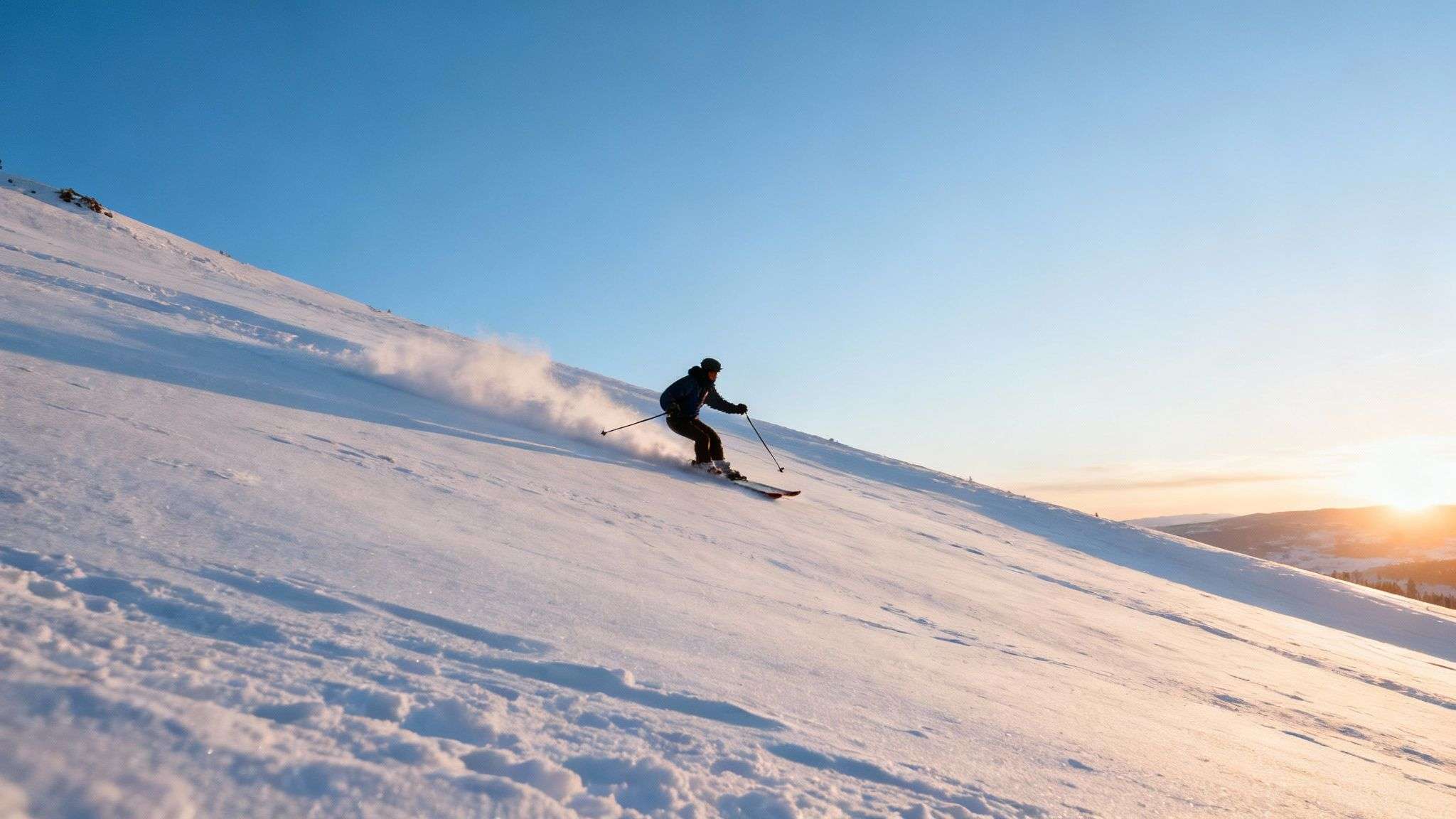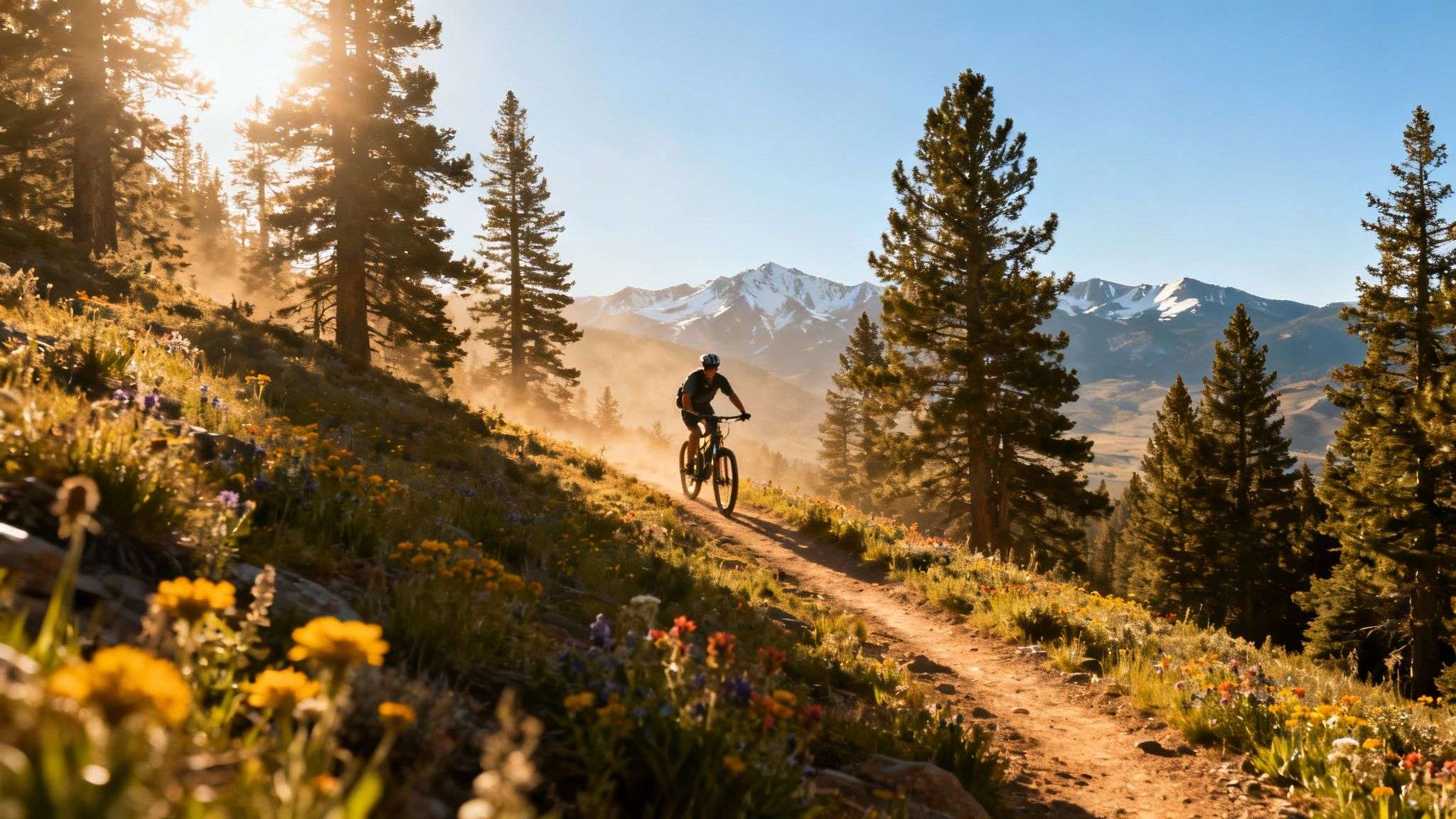Your Guide to Weather in Park City UT
Planning a trip to Park City, Utah? Our guide breaks down the year-round weather, with monthly insights, live data, and local tips for what to pack.
What's the weather like in Park City, Utah? Expect four distinct seasons, from world-class snowy winters perfect for skiing to mild, dry summers ideal for hiking and biking. This guide breaks down the year-round weather patterns, monthly expectations, and local tips to help you pack and plan for your trip.
What to Expect from Park City Weather
 Park City is situated on the eastern side of the Wasatch Mountains, a location that creates a dynamic and inviting climate for outdoor enthusiasts. The local weather is a story of beautiful contrasts. Winters are famously cold and snowy, delivering the light, fluffy powder that put this area on the global ski map. Come summer, the script flips completely. The days are pleasantly mild and dry—a perfect escape from the oppressive heat you’ll find at lower elevations.
Park City is situated on the eastern side of the Wasatch Mountains, a location that creates a dynamic and inviting climate for outdoor enthusiasts. The local weather is a story of beautiful contrasts. Winters are famously cold and snowy, delivering the light, fluffy powder that put this area on the global ski map. Come summer, the script flips completely. The days are pleasantly mild and dry—a perfect escape from the oppressive heat you’ll find at lower elevations.
Key Climate Characteristics
The real driver behind Park City's weather is its elevation, which sits at an average of 7,000 feet. This high-altitude environment is responsible for a few key characteristics every visitor should know.
- Four Distinct Seasons: You’ll get the full experience here—a classic winter, spring, summer, and fall, each bringing its own unique charm and set of activities.
- Big Temperature Swings: It's completely normal for the daily temperature to swing by 20-30 degrees, especially in the spring and fall. A brilliant, sunny afternoon can quickly give way to a crisp, chilly evening.
- Dry Mountain Air: Low humidity makes even the warmest summer days feel comfortable and is the magic behind our legendary light, fluffy snow in winter.
According to U.S. Climate Data, the city's average annual high is 55°F with an average low of 33°F. Annual precipitation averages around 22.39 inches, with most of that falling as snow in the winter months. For a deeper dive into the numbers, you can explore more historical information on Park City's seasonal patterns on usclimatedata.com.
Park City Weather by Season at a Glance
| Season | Average High (°F) | Average Low (°F) | Typical Conditions |
|---|---|---|---|
| Winter | 35 | 14 | Cold, snowy, and perfect for world-class skiing. |
| Spring | 52 | 28 | A mix of sun and snow; conditions can change quickly. |
| Summer | 78 | 48 | Warm, dry, sunny days with cool, pleasant evenings. |
| Fall | 60 | 35 | Crisp air, brilliant fall colors, and fewer crowds. |
Local Tip: Always pack layers, no matter the season. A warm day can quickly become a cool night, and a light jacket or fleece is almost always a good idea for evenings, even in July.
When to Visit Park City Based on Weather

A monthly breakdown provides a closer look at what to expect, helping you nail down the right time for your trip, whether you’re hunting for January powder or chasing September’s golden aspens.
Winter: December – February
January and February are the heart of a Park City winter. These are our coldest months, which is a good thing—it brings the feather-light, dry powder Utah is famous for. Highs struggle to climb out of the 20s, and nights often plummet into the single digits. December marks the full return of winter, with resorts fully open and a reliable snow base building for the season.
Key Insight: January and February are your best bet for experiencing "The Greatest Snow on Earth®." The cold, dry air ensures the snow quality is at its absolute peak.
Spring: March – May
March is a wonderfully mixed bag. One day you'll be skiing in a light jacket under sunny skies, and the next you could be wading through a massive powder storm. April signals the wind-down of the ski season with warmer, slushy conditions. May is classic "mud season" as the snowpack melts, making it a quiet, crowd-free time in town.
Summer: June – August
By June, Park City’s spectacular summer has officially arrived. The trails dry out, and the town buzzes with energy. July and August are our warmest months, but highs usually settle into the upper 70s or low 80s with low humidity. Be prepared for afternoon thunderstorms, which roll in fast and cool things down.
Fall: September – November
September is arguably the most beautiful month in Park City. The summer warmth lingers, but a crispness returns to the evening air as aspen trees paint the mountainsides in brilliant yellows and oranges. October brings a decisive shift toward winter, with cooler temperatures and often the first snow of the season. November is all about the ramp-up to ski season, with resorts making snow and the whole town anticipating opening day.
Average Monthly Weather Data for Park City
A detailed look at Park City's climate throughout the year, including average temperatures and precipitation.
| Month | Avg. High (°F) | Avg. Low (°F) | Avg. Precipitation (in) |
|---|---|---|---|
| January | 29.9 | 6.6 | 2.68 |
| February | 33.3 | 8.8 | 2.28 |
| March | 41.3 | 15.8 | 2.32 |
| April | 50.0 | 22.8 | 2.00 |
| May | 61.1 | 30.6 | 2.28 |
| June | 71.7 | 37.0 | 1.62 |
| July | 80.0 | 43.7 | 1.22 |
| August | 78.2 | 42.6 | 1.73 |
| September | 68.6 | 34.7 | 1.94 |
| October | 55.0 | 25.2 | 2.14 |
| November | 40.0 | 14.8 | 2.40 |
| December | 30.4 | 6.8 | 2.27 |
For an even deeper dive into the climate data, you can explore Park City's climate normals at wrcc.dri.edu.
How to Prepare for Park City Weather

Knowing what to pack and how to travel safely are key to a successful trip. Here are actionable tips for every season.
How to Prepare For Winter Conditions
Dressing for a Park City winter is all about strategic layering to adapt to changing conditions.
- Base Layer: A moisture-wicking layer (merino wool or synthetic) to keep you dry.
- Mid Layer: An insulating layer like a fleece or puffy vest to trap heat.
- Outer Layer: A waterproof and windproof shell (jacket and pants).
Sunscreen and UV-protective sunglasses or goggles are critical due to the sun's reflection off the snow at high altitude. For those planning on winter camping, knowing how to insulate a tent for winter camping is essential.
How to Prepare for Summer Conditions
Packing for summer is about being versatile for warm days and cool evenings.
- Layering is Essential: A t-shirt and shorts are great for midday, but you’ll want a fleece or light jacket for the evening.
- Sun Protection is Non-Negotiable: At 7,000 feet, the sun's UV rays are much stronger. Pack sunscreen, a hat, and sunglasses.
- Stay Hydrated: The dry mountain air dehydrates you quickly. Carry a water bottle and drink more than you think you need.
How to Use Live Data for Your Trip
Historical averages are useful, but real-time data is crucial for making smart, safe decisions. Wasatch Roads provides live data that helps you plan your day.
- Check Road Conditions: Before you leave, use our Wasatch Back Travel Page to check for closures or restrictions on I-80.
- Monitor Mountain Weather: Live weather from resorts gives you the real temperature, wind speed, and snowfall totals.
- View Live Cameras: See conditions for yourself with our collection of live traffic cameras in the Wasatch Mountains.
This proactive approach helps you know if you need to leave early, pack an extra layer, or adjust plans due to an incoming storm. New technologies like AI-enhanced real-time weather alerts are making these forecasts even more precise.
Safe Winter Driving in the Wasatch
Driving during a Utah winter storm demands preparation. While Park City is right off the well-maintained I-80, conditions can change rapidly.
- Vehicle Prep: Ensure your car has snow tires or M+S-rated tires. A 4WD or AWD vehicle is highly recommended.
- Know the Law: During storms, UDOT often implements traction laws. It's crucial to understand these requirements. Get familiar with the Utah traction law in our detailed guide.
- Plan for Canyon Travel: If your trip includes a visit to the ski resorts in Little Cottonwood Canyon or Big Cottonwood Canyon, checking road status is non-negotiable.
Planning for Spring and Fall Shoulder Seasons

The shoulder seasons—spring (April-May) and fall (September-October)—offer thinner crowds and better deals but come with unpredictable weather. Spring is known as "mud season," as melting snow makes trails messy. Fall offers crisp air and stunning foliage, especially from mid-September to early October.
Key Takeaway: The key to enjoying the shoulder seasons is to prepare for everything. Your packing list should include a mix of winter and summer gear—think a warm hat and gloves right next to a t-shirt and sunglasses.
Flexibility is essential. Have backup plans like exploring Historic Main Street, visiting the Park City Museum, or taking a scenic drive over Guardsman Pass (check for seasonal closures).
Park City Weather FAQ
When is the best time to visit Park City for skiing?
For the legendary light, dry Utah powder, the sweet spot is from late January through early March. This period offers the deepest snow base, the most consistent storms, and cold temperatures that keep the snow in prime condition.
Do I need a 4WD vehicle in the winter?
A 4WD or AWD vehicle with proper snow tires is highly recommended. While I-80 is well-plowed, storms can create slick conditions quickly. If you plan to visit resorts in Little Cottonwood Canyon or Big Cottonwood Canyon, a 4WD/AWD vehicle is often required by law during storms.
How should I dress for a summer evening in Park City?
Always bring layers. Even after a warm day, temperatures drop quickly once the sun sets. A light jacket, fleece, or sweater is a must for evenings, especially for outdoor dining or concerts.
For the most reliable, up-to-the-minute road and weather information for your mountain adventure, trust Wasatch Travel Helper. Plan your trip with live data at https://wasatchroads.com.